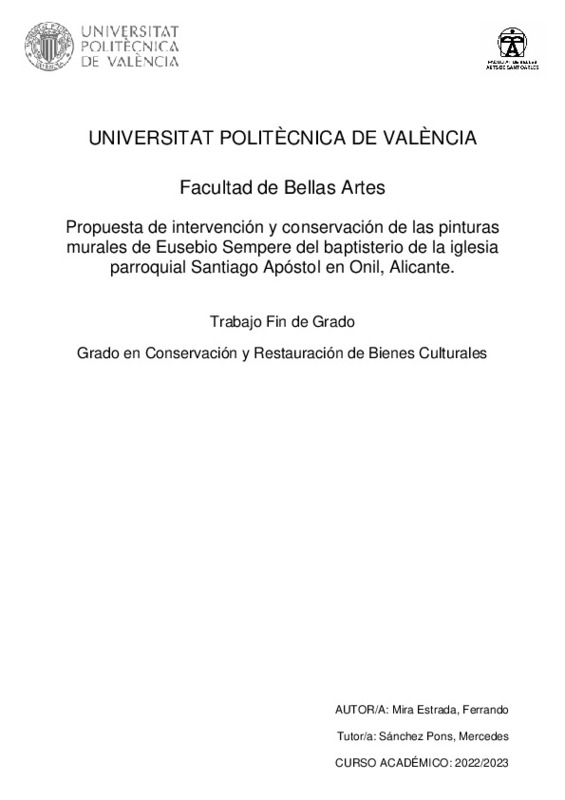JavaScript is disabled for your browser. Some features of this site may not work without it.
Buscar en RiuNet
Listar
Mi cuenta
Estadísticas
Ayuda RiuNet
Admin. UPV
Propuesta de intervención y conservación de las pinturas murales de Eusebio Sempere del baptisterio de la iglesia parroquial Santiago Apóstol en Onil, Alicante.
Mostrar el registro completo del ítem
Mira Estrada, F. (2023). Propuesta de intervención y conservación de las pinturas murales de Eusebio Sempere del baptisterio de la iglesia parroquial Santiago Apóstol en Onil, Alicante. Universitat Politècnica de València. http://hdl.handle.net/10251/200205
Por favor, use este identificador para citar o enlazar este ítem: http://hdl.handle.net/10251/200205
Ficheros en el ítem
Metadatos del ítem
| Título: | Propuesta de intervención y conservación de las pinturas murales de Eusebio Sempere del baptisterio de la iglesia parroquial Santiago Apóstol en Onil, Alicante. | |||
| Otro titulo: |
|
|||
| Autor: | Mira Estrada, Ferrando | |||
| Director(es): | ||||
| Entidad UPV: |
|
|||
| Fecha acto/lectura: |
|
|||
| Resumen: |
[ES] Este trabajo de fin de grado se centra en el estudio histórico, artístico e iconográfico de unas pinturas murales realizadas por el artista alicantino Eusebio Sempere con la intención de difundir su conocimiento y ...[+]
[EN] This final degree project focuses on the historical, artistic and iconographic study of some wall paintings by the Alicante artist Eusebio Sempere with the intention of disseminating knowledge of them and assessing ...[+]
|
|||
| Palabras clave: |
|
|||
| Derechos de uso: | Reserva de todos los derechos | |||
| Editorial: |
|
|||
| Titulación: |
|
|||
| Tipo: |
|
recommendations
Este ítem aparece en la(s) siguiente(s) colección(ones)
-
BBAA - Trabajos académicos [5086]
Facultad de Bellas Artes







